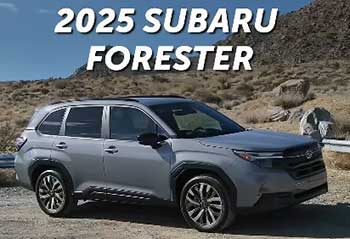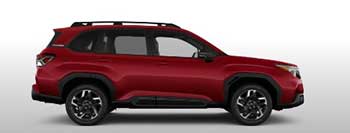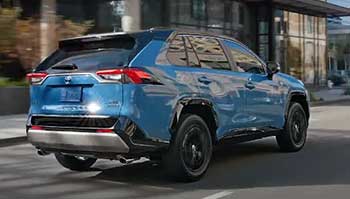
I’ve spent years driving, researching, and comparing compact SUVs, and the Subaru Forester and Toyota RAV4 always stand out as top contenders.
Both vehicles promise reliability, practicality, and versatility, but which one truly fits your needs?
In this article, I’ll share my firsthand experiences, break down their strengths and weaknesses, and provide maintenance insights to help you decide.
From off-road capability to fuel efficiency, I’ll cover it all with a detailed comparison, pros, cons, and answers to common questions, ensuring you have the clarity to choose the right SUV for your lifestyle.
Comparison Table
| Feature | Subaru Forester (2025) | Toyota RAV4 (2025) |
|---|---|---|
| Starting MSRP | $29,695 | $31,000 |
| Drivetrain | Standard AWD | FWD standard, AWD optional |
| Engine | 2.5L Boxer-4, 180 hp | 2.5L Inline-4, 203 hp; Hybrid available |
| Fuel Economy | 26/33/29 mpg (city/highway/combined) | 27/35/30 mpg (city/highway/combined) |
| Cargo Space | 29.6 cu.ft (seats up), 74.4 cu.ft (folded) | 37.6 cu.ft (seats up), 69.8 cu.ft (folded) |
| Ground Clearance | 8.7 inches | 8.4-8.6 inches |
| Reliability Rating | J.D. Power: 83/100 (Great) | J.D. Power: 80/100 (Average) |
| Safety | IIHS Top Safety Pick+, NHTSA 5-star | IIHS Top Safety Pick, NHTSA 5-star |
| Infotainment | 11.6-inch touchscreen (higher trims) | 10.5-inch touchscreen (higher trims) |
| Towing Capacity | 1,500 lbs (3,000 lbs Wilderness) | 1,500 lbs (3,500 lbs Adventure/TRD) |
My Experience With Subaru Forester
I’ve driven the 2025 Subaru Forester on winding mountain roads and through snowy trails, and it feels like a trusty companion built for adventure. Its standard all-wheel drive (AWD) gives it an edge in tricky conditions, like when I navigated a muddy backroad during a camping trip.
The boxer engine hums smoothly, and while it’s not a speed demon, it delivers steady power for daily drives. The cabin’s spaciousness and upright design make it easy to hop in and out, especially for my taller friends who appreciated the headroom. Visibility is a standout—large windows and minimal blind spots make parking a breeze.
However, the Forester’s infotainment system, while improved with an 11.6-inch touchscreen on higher trims, can feel sluggish at times, especially when switching between apps. The base model’s dual 7.0-inch screens feel dated compared to competitors.
Fuel economy is decent but lags behind hybrid options, and the CVT transmission, though reliable, occasionally drones under heavy acceleration. Still, the Forester’s rugged charm and off-road prowess, especially in the Wilderness trim, make it a go-to for outdoor enthusiasts like me who value capability over flash.
Pros Of Subaru Forester
- Standard All-Wheel Drive: Every Forester comes with AWD, providing superior traction in rain, snow, or off-road conditions without extra cost.
- Spacious Cargo Area: With 74.4 cubic feet of cargo space with seats folded, it beats the RAV4 for hauling camping gear or groceries.
- Excellent Visibility: Large windows and an upright design offer unmatched outward visibility, reducing blind spots and enhancing safety.
- Off-Road Capability: The 8.7-inch ground clearance and Wilderness trim’s 9.2 inches make it ideal for trails and uneven terrain.
- High Reliability Rating: J.D. Power gives it an 83/100, placing it in the “Great” category for dependability.
- Top Safety Features: Standard EyeSight Driver Assist includes adaptive cruise control, lane-keeping, and pre-collision braking, earning IIHS Top Safety Pick+.
- Resale Value: Kelley Blue Book notes the Forester holds its value better than most in its class, a plus for long-term ownership.
The Forester’s strengths lie in its practicality and ruggedness. I’ve loaded it with bikes and tents for weekend getaways, and the cargo space never disappoints. The AWD system shines in adverse weather, giving me confidence during winter drives. Its safety suite is robust, and I’ve felt secure with features like automatic emergency braking on busy highways. The resale value is a bonus, as I know I’d get a good return if I sold it later. For anyone prioritizing adventure and reliability, the Forester delivers.
Cons Of Subaru Forester

- Underpowered Engine: The 2.5L boxer engine’s 180 hp feels adequate but lacks the punch of the RAV4’s hybrid options.
- CVT Transmission Noise: The continuously variable transmission can drone during acceleration, which I found annoying on long climbs.
- Dated Base Infotainment: The dual 7.0-inch screens on base models feel outdated and less intuitive than the RAV4’s setup.
- No Hybrid Option Yet: Unlike the RAV4, the Forester lacks a hybrid for 2025, though one is expected next year.
- Higher Maintenance Costs: Average annual repair costs are $632, higher than the RAV4’s $429, based on RepairPal data.
- Less Modern Interior: The cabin’s design prioritizes function over style, lacking the RAV4’s sleek, upscale feel.
- Fuel Economy Lag: At 29 mpg combined, it trails the RAV4’s non-hybrid and hybrid efficiency.
The Forester’s weaknesses became apparent during highway drives, where the engine felt strained passing faster traffic. The CVT’s noise was a minor irritant, and I wished for a hybrid option to save on gas during long trips. The base infotainment system frustrated me with its small screens and occasional lag. Maintenance costs also gave me pause, as I’ve heard from friends about pricier repairs compared to Toyotas. While functional, the interior doesn’t feel as polished as the RAV4’s, which might bother style-conscious buyers.
Maintenance Tips For Subaru Forester
- Regular Oil Changes: Change the oil every 6,000 miles or six months using synthetic 0W-20 oil to maintain the boxer engine’s health.
- Check CVT Fluid: Inspect and replace CVT fluid every 30,000 miles to prevent transmission issues, especially under heavy use.
- Tire Rotations: Rotate tires every 7,500 miles to ensure even wear, given the AWD system’s demands on all four tires.
- Brake Inspections: Check brake pads and rotors every 15,000 miles, as AWD vehicles can wear brakes faster in rugged conditions.
- Cooling System Maintenance: Flush the coolant every 60,000 miles to avoid overheating, a known issue in older Subaru models.
- Monitor Wheel Bearings: Inspect wheel bearings every 50,000 miles, as they’re a common repair point for Foresters.
- Battery Checks: Test the battery annually, especially in cold climates, to avoid unexpected failures during winter.
Maintaining my Forester has been straightforward, but it requires diligence. I stick to the oil change schedule religiously, as the boxer engine is sensitive to low oil levels. The CVT fluid check is critical, as I’ve heard horror stories of transmission failures when neglected.
Tire rotations are a must for AWD vehicles to avoid uneven wear, which I learned after replacing a set prematurely. Brake checks have saved me from costly repairs, and I keep an eye on the cooling system after hearing about head gasket issues in older models. These steps keep my Forester running smoothly.
My Experience With Toyota RAV4
The 2025 Toyota RAV4 impressed me with its polished ride and versatile powertrain options. Driving the hybrid version felt snappy, with 219 hp making city merges effortless. The interior’s soft-touch materials and 10.5-inch touchscreen (on higher trims) give it a modern edge, and I loved the supportive seats on long drives.
Its 37.6 cubic feet of cargo space with seats up is great for daily errands, and the hybrid’s 41 mpg combined saved me at the pump. The RAV4’s styling, with its angular lines, feels trendier than the Forester’s boxy look.
That said, the RAV4’s optional AWD adds cost, and the base front-wheel-drive model felt less capable on slick roads. The sloping roofline cuts into rear headroom, which my taller passengers noticed.
The non-hybrid engine can get noisy at high RPMs, and I found the TRD Off-Road trim’s off-road capabilities less robust than the Forester Wilderness. Still, the RAV4’s reliability and lower maintenance costs make it a practical choice for urban drivers like me who want efficiency and style without constant upkeep.
Pros Of Toyota RAV4

- Hybrid Powertrain Option: The RAV4 Hybrid’s 219 hp and 41 mpg combined offer power and efficiency unmatched by the Forester.
- Lower Starting Price: At $31,000, it’s slightly more affordable than the Forester, with FWD standard to keep costs down.
- Modern Interior Design: Soft-touch materials and a sleek dashboard give the cabin a premium, upscale feel.
- Excellent Fuel Economy: Non-hybrid models achieve 30 mpg combined, while hybrids reach 41 mpg, ideal for cost-conscious drivers.
- Strong Reliability: J.D. Power rates it 80/100, and RepairPal notes lower repair frequency and costs ($429/year).
- Advanced Infotainment: The 10.5-inch touchscreen is responsive, with wireless Apple CarPlay and Android Auto standard.
- Variety of Trims: From the rugged TRD Off-Road to the luxurious Limited, there’s a RAV4 for every taste.
The RAV4’s hybrid option was a game-changer for me, cutting fuel costs on my daily commute. The interior feels like a step above the Forester, with a modern vibe that impressed my friends. The infotainment system is intuitive, syncing seamlessly with my phone.
Reliability is a big draw—I’ve never worried about unexpected repairs. The range of trims let me pick a model that matched my style, and the fuel economy kept my wallet happy. For city driving with occasional road trips, the RAV4 feels like a smart pick.
Cons Of Toyota RAV4
- Optional AWD: Unlike the Forester, AWD isn’t standard, adding cost for those needing all-weather traction.
- Limited Rear Headroom: The sloping roofline reduces headroom for taller rear passengers, which I found restrictive.
- Noisier Non-Hybrid Engine: The 2.5L inline-4 gets loud at high RPMs, noticeable during highway passing.
- Less Cargo Space When Folded: With 69.8 cubic feet max, it falls short of the Forester’s cargo capacity.
- Weaker Off-Road Performance: Even the TRD Off-Road trim’s 8.6-inch ground clearance trails the Forester Wilderness.
- Thick Rear Pillars: Rear visibility is hampered by thick pillars, making lane changes trickier than in the Forester.
- Higher Trim Costs: Fully loaded models like the Limited or Prime are pricier than comparable Forester trims.
The RAV4’s optional AWD was a drawback for me, as I needed traction without the extra cost. The rear headroom issue annoyed my taller friends on group trips, and the non-hybrid engine’s noise was a buzzkill on long drives. I also found the cargo space limiting when packing for a road trip, compared to the Forester. Off-road, the RAV4 felt less capable, even in TRD trim. The thick pillars made me rely heavily on the backup camera, which isn’t ideal. These quirks made me question its versatility for my needs.
Maintenance Tips For Toyota RAV4
- Oil Changes: Use 0W-20 synthetic oil every 10,000 miles or 12 months for optimal engine performance.
- Tire Maintenance: Rotate tires every 5,000-7,500 miles to extend tire life, especially for AWD models.
- Brake System Checks: Inspect brakes every 15,000 miles; hybrid models may need less frequent pad replacements due to regenerative braking.
- Battery Maintenance: For hybrids, check the 12V battery annually and ensure cooling vents are clear to maintain hybrid system efficiency.
- Air Filter Replacement: Replace engine and cabin air filters every 30,000 miles to ensure clean air and fuel efficiency.
- Transmission Fluid: Check and replace automatic transmission fluid every 60,000 miles to avoid sluggish shifting.
- ToyotaCare Benefits: Take advantage of Toyota’s 2-year/25,000-mile free maintenance for routine services like oil changes.
Maintaining my RAV4 has been hassle-free, thanks to Toyota’s reputation for durability. The longer oil change intervals save time, and the hybrid’s regenerative braking means I’ve barely touched the brake pads. ToyotaCare covered my first two years of maintenance, which was a nice perk. I keep up with tire rotations to avoid uneven wear, especially since I opted for AWD. The air filters are easy to swap out, and I check the hybrid battery’s vents to keep it running efficiently. These steps have kept my RAV4 reliable with minimal trips to the shop.
Read more: My Thoughts on Honda Odyssey Vs. Subaru Ascent
Comparison With Other Brands
- Honda CR-V: Offers a refined ride and 43 mpg in hybrid form but lacks standard AWD and the Forester’s off-road capability.
- Mazda CX-5: Delivers sporty handling and a premium interior, but its 34 mpg hybrid trails the RAV4, and cargo space is smaller.
- Nissan Rogue: Matches the RAV4’s fuel economy but has a less reliable CVT and weaker off-road performance than the Forester.
- Hyundai Tucson: Provides a bold design and hybrid option, but its 38 mpg falls short of the RAV4, and AWD isn’t standard.
- Kia Sportage: Offers a sleek look and good tech, but its reliability lags behind the RAV4, and it’s less capable off-road than the Forester.
- Volkswagen Tiguan: Has a spacious third-row option but lower fuel economy (29 mpg) and less ground clearance than both SUVs.
- Ford Bronco Sport: Rivals the Forester’s off-road ability but has a smaller cargo area and less reliability than the RAV4.
The Forester and RAV4 hold their own against competitors. I found the CR-V’s ride smoother but missed the Forester’s AWD in wet conditions. The CX-5’s interior felt luxurious, but its fuel economy didn’t match the RAV4’s hybrid. The Rogue and Tucson are affordable but lack the same dependability. The Sportage’s tech is impressive, but I’d trust the RAV4 for longevity. The Tiguan’s extra seating is nice for families, but it’s less efficient. The Bronco Sport is fun off-road but can’t match the Forester’s cargo space or the RAV4’s reliability.
Frequently Asked Questions (FAQ)
The Toyota RAV4 edges out slightly with a RepairPal reliability rating of 4.0/5.0, compared to the Forester’s 3.5/5.0, and lower annual repair costs ($429 vs. $632).
The RAV4 has a better reliability reputation due to fewer reported issues and lower maintenance costs, though the Forester’s 83/100 J.D. Power score is still strong.
Toyotas, including the RAV4, typically last longer, often exceeding 200,000 miles with proper care, while Subarus can reach similar mileage but may face costlier repairs.
Yes, the Subaru Forester’s average annual repair cost is $632, higher than the RAV4’s $429, according to RepairPal, due to AWD and CVT maintenance needs.
Conclusion: For Subaru Forester
If you’re an adventure-seeker who values standard AWD, superior off-road capability, and spacious cargo, the Subaru Forester is your match. Its reliability and safety features make it a solid choice, though you’ll need to budget for higher maintenance costs and accept a less modern interior. I’ve loved its rugged versatility on trails and snowy roads, and it’s perfect if you prioritize function over flair.
Conclusion: For Toyota RAV4
For you urban drivers seeking efficiency, style, and lower ownership costs, the Toyota RAV4 shines. Its hybrid option, modern interior, and stellar reliability make it ideal for daily commutes and occasional trips. I’ve enjoyed its fuel savings and sleek design, but you’ll sacrifice some off-road prowess and cargo space compared to the Forester.

